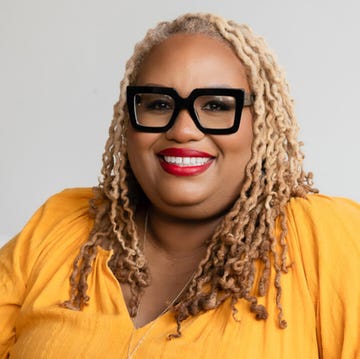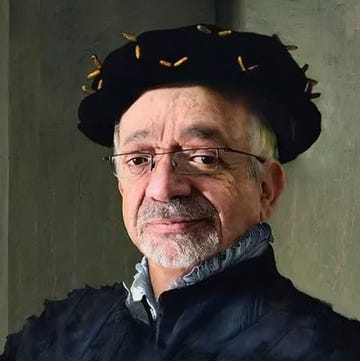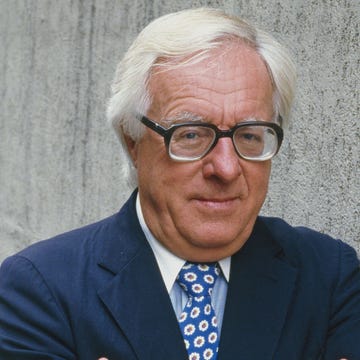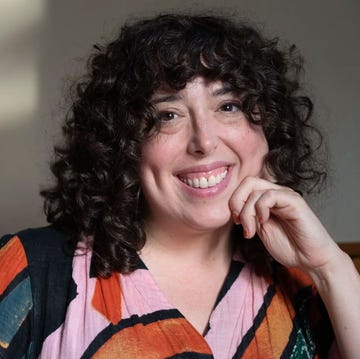My favorite figure from Los Angeles history has long been Aimee Semple McPherson. No one else even comes close. She was, in her time, the city’s ur-figure, its (to borrow from Friedrich Nietzsche) Übermensch. And yet, she is almost entirely overlooked today. Could there be a more fitting metaphor for Southern California’s parallel cultures of reinvention and erasure, the storied impermanence of the place? If, like all metaphors, this is a gloss, that doesn’t mean it is inaccurate.
Born in 1890 in rural Canada, McPherson—or Sister Aimee, as she would come to be known—was already an evangelist when she decided to travel to the West Coast in 1918. Widowed in Hong Kong, where she and her first husband were engaged in missionary work, she had long since returned to North America: first to New York, where her mother worked with the Salvation Army, and then a series of tent revivals throughout the United States. In Los Angeles, she built her Church of the Foursquare Gospel on the foundation of the Azusa Street Revival, considered to be ground zero for the worldwide Pentecostal movement, and by 1923 she had constructed the Angelus Temple, a tabernacle with seating for more than 5,000 that, more than a century later, remains not only standing but also in use in Echo Park, despite H.L. Mencken’s 1926 assessment that it was “very cheaply made.”
Mencken’s critique does not appear in Claire Hoffman’s excellent biography Sister, Sinner: The Miraculous Life and Mysterious Disappearance of Aimee Semple McPherson, but it can be seen as part of the book’s DNA. Among the contentions in these pages is that McPherson was both huckster and true believer, which makes her narrative even more representative of Los Angeles. “I think it’s like a circle,” Hoffman told me on a recent Zoom call. “When you think about an extreme believer and an extreme charlatan, they are actually right next to each other in her case.”
Something similar might be said of any—or every—celebrity.
Celebrity, to be sure, sits at the center of the McPherson story. She was media savvy and an early adopter of new technologies. In 1924, she became the second woman in the United States to receive a broadcast license, for her church’s radio station, KFSG-AM. She palled around with movie stars, including, on one notable occasion, Charlie Chaplin, who sought to debate her on the subject of religion. Hoffman writes that the evangelist responded, “Our worlds are different…vastly different,” before “redirect[ing] the conversation to their shared profession of entertainment.” Throughout the 1920s and 1930s, McPherson—or characters based on her—appeared in novels such as Sinclair Lewis’s Elmer Gantry, Upton Sinclair’s Oil!, Myron Brinig’s The Flutter of an Eyelid, Nathanael West’s The Day of the Locust, and Aben Kandel’s Rabbi Burns.
At the same time, Hoffman understands, this lens is far too narrow, rendering McPherson in two dimensions, less human being than archetype. Sister, Sinner, then, makes a reclamation. The book begins with the most sensational episode in a life of sensational episodes: the evangelist’s disappearance, on May 18, 1926, from Ocean Park Beach in Santa Monica and her subsequent reemergence, five weeks later, in Douglas, Arizona, where she claimed to have escaped from kidnappers. In fact, she had run off with the temple’s married radio engineer, Kenneth Ormiston, and the kidnapping story unraveled almost immediately. By the end of 1926, she was facing indictment for obstruction of justice, and although charges were not filed, the taint of it, the impression that she had lied, never went away.
“It’s confounding,” Hoffman acknowledged during our conversation. “I think she thought she could keep being in charge of her story. But she really underestimated the power of the press.” The story was front-page news—not only in Los Angeles but also internationally. That McPherson did not anticipate this, Hoffman continued, indicates a naïveté “that is important in understanding her. For all her success, her worldliness, she was super gullible in a way.”
That gullibility brings us back to the central contradiction, or conundrum, of McPherson’s existence: sister and sinner, in the title’s terms. What makes her interesting is that she can’t be pigeonholed. What makes her interesting is that she was both. Unlike other evangelists—her rival “Fighting Bob” Shuler comes to mind—she preached love rather than damnation. In keeping with the ethos of the Azusa Street Revival, her congregations were racially mixed, and she diversified the power structure of the Church of the Foursquare Gospel. “Aimee had three ministerial assistants and a board of seven elders,” Hoffman writes, “along with twenty-one deacons—fourteen of them women.” In her way, she was a proto-feminist.
Still, there was a dark side, and in the wake of the kidnapping scandal, McPherson began to seem almost Trumpian in affect. She blamed the courts and the media for her misfortune, repeatedly spinning her own version of events. “She was shameless,” Hoffman explained over Zoom—not in the sense of being brazen but rather in being unashamed. “She was just so convinced of her story. You feel her trying to make the world. So, even with the kidnapping, it’s like if she just tells that story the same way, over and over and over, and yells about the people who doubt her, then it will bend to her will.”
In the end, she never regained what she had lost, although she kept the Church of the Foursquare Gospel going. It remains a thriving entity to this day. More to the point, she carved out and, as best she could, preserved a place for herself against all odds.
“There were not,” Hoffman told me, “a lot of opportunities for women who were ambitious. So this was kind of perfect, because it’s completely selfless, right? You’re doing it for Jesus. You’re not doing it for your own fame. I think, truly, she believed in every cell of her being that she was a messenger for God, and the confidence that gave her is incredible. I’m not going to submit articles to a Pentecostal magazine. I’m going to start my own Pentecostal magazine. I’m not going to visit other churches. I’m going to start my own church. I’m not going to be credited by some other denomination. I’m going to start my own denomination. I’m going to start my own radio station. You don’t see a lot of women in history getting to do that.”•














